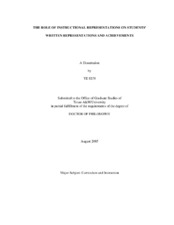| dc.description.abstract | This research is based on Middle School Mathematics Project (MSMP) funded
by the Interagency Educational Research Initiative through a grant to the American
Association for the Advancement of Science. Both teacher’s instructional
representations and students’ written representations were coded and analyzed to
investigate the nature and structure of the representations in teaching fractions, decimals
and percents in middle school classrooms in three school districts in Texas. The study
further explored the relationship between both the quality and quantity of instructional
representations and students’ written representations, and the relationship between
students’ written representations and their achievements.
This dissertation used a mixed approach utilizing both quantitative and
qualitative methods. The data was collected in the first two years of a five-year study. A
total of 14 sixth grade mathematics teachers from three school districts in Texas were
selected from the MSMP project. Before the actual videotaping procedure, a professional
development focusing on multiple representations was held for the teachers. Both pretests and posttests were used to examine the relationship between the structure of
students’ written representations and their achievements.
The results showed that the both the quantity and quality of teachers’
instructional representations varied a lot. Symbolic representations were the predominant
representations in classroom teaching. Structures of instructional representations
converge to content sub-constructs rather than format sub-constructs. Here subconstructs
include part-whole, measure, quotient, multiplication by one and cross
product. Instead, format sub-constructs include real world, manipulatives, pictures,
spoken symbolic representations and written symbolic representations, however,
connections between these sub-constructs were not statistically significant. Within the
three content sub-constructs (part-whole, quotient, and multiplication by one) that
revealed by students’ written representations, quotient and multiplication by one
significantly predicated the students’ posttest scores. It was also found that, among the
three quality criteria (accuracy, comprehensibility and connections) of instructional
representations, the comprehensibility score significantly predicated students’
achievement in the posttests. | en |


